FLOWER POWER!!
When you first think of flowers you think of a nice gift from a loved one or going to Lowes to get your hanging baskets but in reality – wildflowers grow all around us if we are willing to look for them. I went back to Spring Valley nature preserve to find some blooming babies and here they are!
Dames Violet
This purple beauty was a quick find on the roadside and then found every place I went to find some flowers. It was invading many areas and it was found that they disperse easily! Tons of their seeds hook on to wildlife and get carried until they are dropped and planted. https://www.appliedeco.com/dames-rocket/
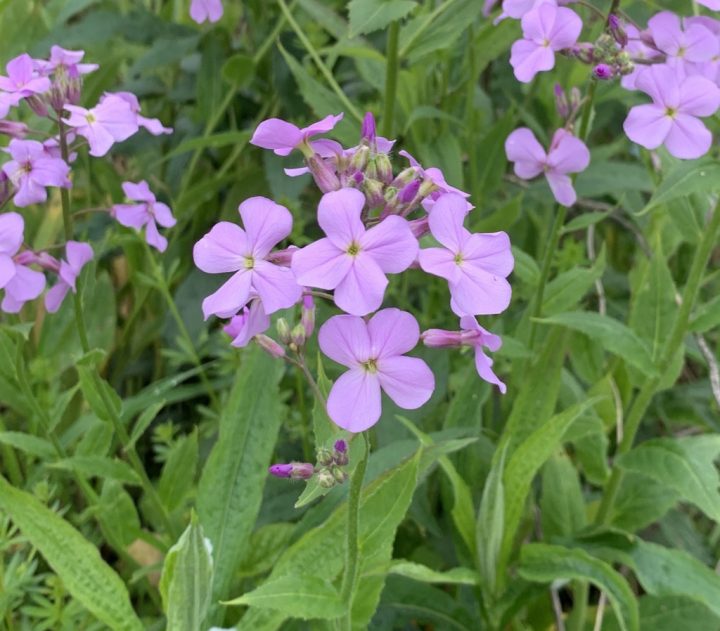
INVADER = DAME’S VIOLET!
This flower was found here: Roadside at Buckeye Lake AND all over Spring Valley Nature Preserve – rocky soil with some moisture
It is on page 138 in Newcomb’s Wildflowers
Common name Dames Violet Scientific name: Hesperis matronalis
Corolla: number of petals __4___ separate or fused? Separate
Calyx: number of sepals __4___ separate or fused? Separate
Androecium: number of stamens __6__ separate, fused, or arranged in any special way? Separate
Gynoecium type: syncarpous (and # of carpels =_1___)
How can you tell? (Cite the features were apparent about the number of carpels.)
The ovary was large after you peeled away the petals and sepals – probably syncarpous with “many rooms”
Flower type/ovary position: perigynous – cup shape!
Flower symmetry: actinomorphic (regular)
Additional distinctive features: Can be both purple and white! They were EVERYWHERE!!!
Wild Blue Phlox
We now are off the road and on the trails at Spring Valley Nature Preserve! We got another purple baby which ended up being phlox! COOL! I had seen phlox in some garden centers but it is pretty neat that it is native around here! This native can be perfect for pollinators but also can be a perfect snack for hungry bunnies! (https://gobotany.nativeplanttrust.org/species/phlox/divaricata/)
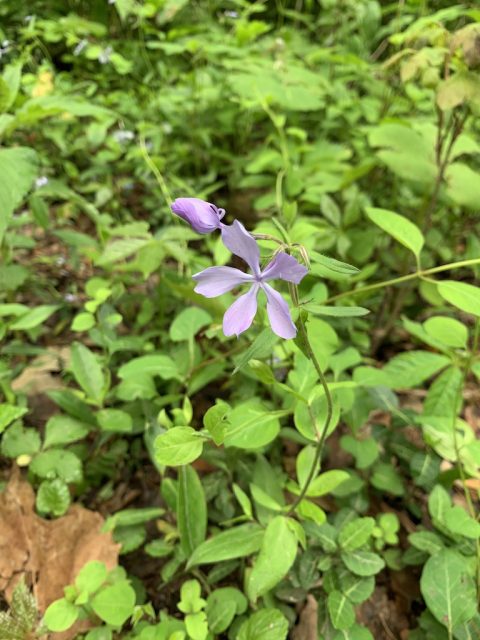
Wild Blue (?) Phlox! ..looks purple to me
This flower was found here: Spring Valley – high ground with rocky soil
It is on page 248 in Newcomb’s Wildflowers
Common name: Wild Blue Phlox Scientific name: Phlox divaricata
Corolla: 5 fused petals
Calyx: 5 fused sepals
Androecium: number of stamens ___4__ separate, fused, or arranged in any special way? Separate
Gynoecium type: syncarpous(and # of carpels =__1___)
How can you tell? Ovary had small chambers inside – very small
Flower type/ovary position: perigynous
Flower symmetry: actinomorphic (regular)
Additional distinctive features: Nearby there was a similarly shaped flower that was white – it looked like wild blue phlox that had run out of ink in the printer!
Broad-leaved Waterleaf
This next one caught my eye with its super projected stamen! I mean look at them go! Also I am realizing that purple flowers are more common than I thought! The leaves do look like (Canada) maple leaves and can be connected to its name (Canadense)! (http://www.namethatplant.net/plantdetail.shtml?plant=713)
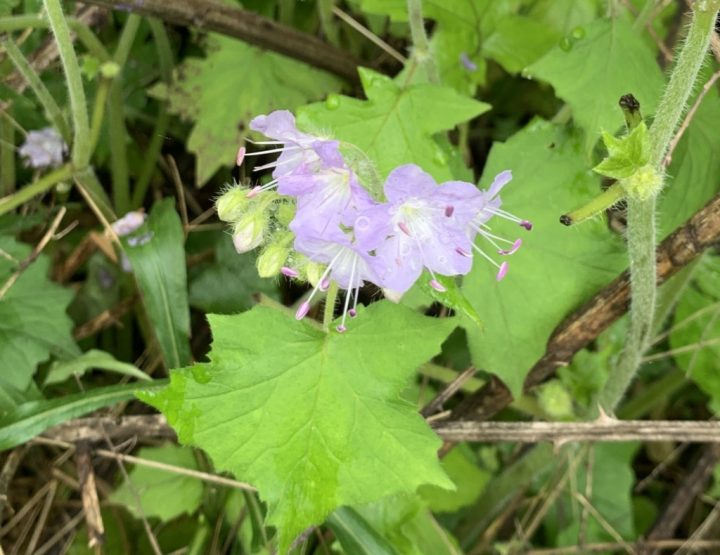
Is that a maple leaf! No silly its a Waterleaf
This flower was found here: Spring Valley – near a stream with wet – ish soil
It is on page 208 in Newcomb’s Wildflowers
Common name: Broad-leaved Waterleaf Scientific name: Hydrophyllum canadense
Corolla: 5 fused petals
Calyx: 5 fused sepals
Androecium: number of stamens ___5__ separate, fused or arranged in any special way? Separate
Gynoecium type: unicarpellate (and # of carpels =__1___)
How can you tell? This one was tough because the ovary was very difficult to find. It was fairly round without ridges so – maybe unicarpellate?
Flower type/ovary position: perigynous – Definite cup shape!
Flower symmetry: actinomorphic (regular)
Additional distinctive features: There was definitely some protandry going on! The stamen were out and about doing their thing and the pistil had barely developed!!
White Baneberry
Wait a minute! This isn’t purple for once! AND it is weird with so many petals and stamen!! What is HAPPENING!
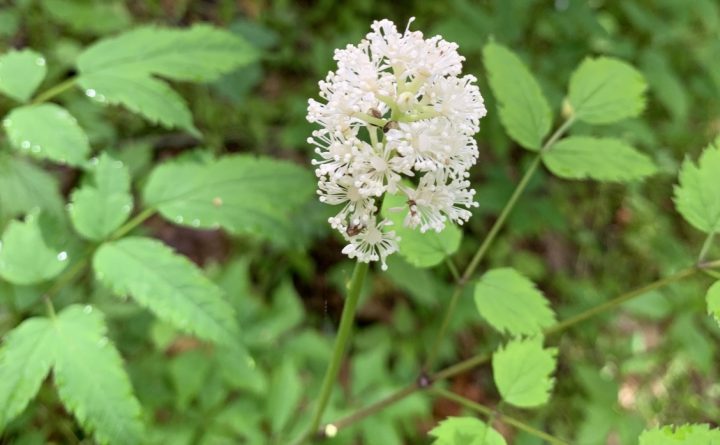
Natures Q-tip – but in the best way
This flower was found here: Spring Valley – high ground with rocky soil
It is on page 424 in Newcomb’s Wildflowers
Common name: White Baneberry Scientific name: Actaea pachypoda
Corolla: Maybe 5? (indistinguishable ) but separate Hard to tell but I counted 5 or 6 actual petals and MANY stamens
Calyx: Indistinguishable – I was unsure of where the sepals started and the petals ended. Usually the sepals were green right below the petals but they were not there!
Androecium: number of stamens ___20? LOTS__ separate, fused, or arranged in any special way? Separate
Gynoecium type: syncarpous(and # of carpels =__1___)
How can you tell? Ovary looked as if it had chambers
Flower type/ovary position: Hypogynous
Flower symmetry: actinomorphic (regular)
Additional distinctive features: This fun flower had so many petals and stamen! Also I read up on it and found it to be poisonous. Its name even calls on this with bane – berry (bad berry). https://www.softschools.com/facts/plants/white_baneberry_facts/1958/
Daisy Fleabane
Daisies are a favorite of mine! They are classic and so cute! This one stood out to me because of its large amount of petals and its pink tint! Its name arises from the tale that its dried plant could be used to get rid of fleas. (http://www.bio.brandeis.edu/fieldbio/Wildflowers_Kimonis_Kramer/PAGES/DAISYFLEABANE_PAGE_FINAL.html)
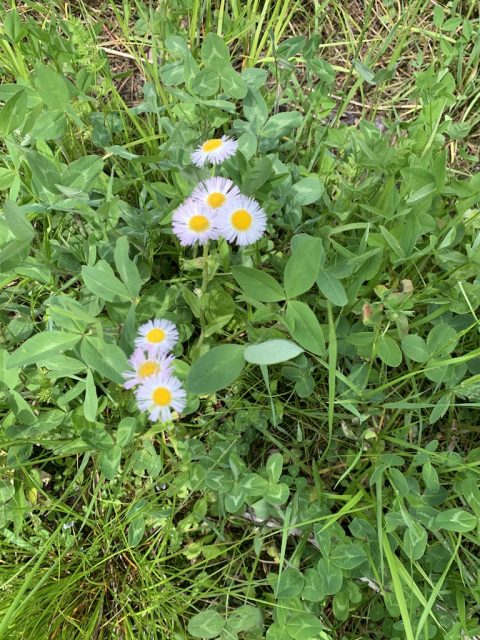
Cluster of Daisy Fleabanes
This flower was found here: Spring Valley – near the stream and in a large field
It is on page 382 in Newcomb’s Wildflowers
Common name: Daisy Fleabane Scientific name: Erigeron annuus
Corolla: Many, many separated petals
Calyx: 10ish fused sepals
Androecium: number of stamens ___many__ separate, fused, or arranged in any special way? Separate – I was unsure of the stamens here. The yellow pad-like structure seemed to be a ton of stamens.
Gynoecium type: syncarpous(and # of carpels =__1___)
How can you tell? The ovary was underneath the stamens and difficult to decipher – possibly multi-chambered.
Flower type/ovary position: Epigynous – Again, it was hard to tell but beneath the sepals and petals there was a bulging area which I assumed to be the ovary? But deconstructing the flower only made it fall apart… RATS! ITS A MYSTERY
Flower symmetry: actinomorphic (regular) – There were many petals but was generally symmetrical
Additional distinctive features: Pulling out the yellow tips revealed feathery filaments. I assume this helps distribute the pollen via wind? Pretty neat!
Thyme-leaved Sandwort
Another teeny tiny flower! This one had blooms about the size of an eraser and the giveaway was the leaf shape! Looks like thyme!

Thyme-leaved sandwort with little flowers!
This flower was found here: Spring Valley – high ground with rocky soil
It is on page 276 in Newcomb’s Wildflowers
Common name: Thyme-leaved Sandwort Scientific name: Arenaria serpyllifolia
Corolla: 5 fused petals
Calyx: 5 fused sepals
Androecium: number of stamens ___10__ separate, fused or arranged in any special way? Separate
Gynoecium type: Unicarpellate (and # of carpels =__1___)
How can you tell? Ovary seemed to have one seed pod
Flower type/ovary position: Hypogynous
Flower symmetry: actinomorphic (regular)
Additional distinctive features: The leaves were shaped like thyme leaves (hint the name!!) This plant is so small and can often be missed! (http://www.luontoportti.com/suomi/en/kukkakasvit/thyme-leaved-sandwort)
Yellow Aven
This one was very sneaky. It was super tiny and barely caught my eye with its yellow color! You can’t hide from me Aven!
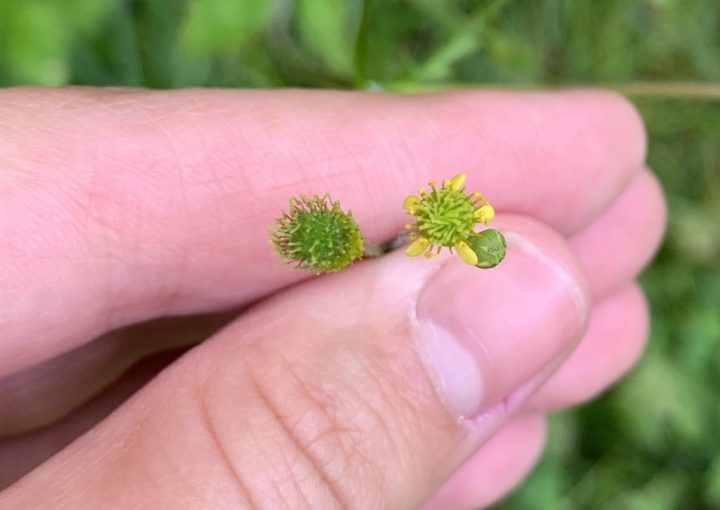
Little Yellow aven!
This flower was found here: Spring Valley – near a field and stream
It is on page 238 in Newcomb’s Wildflowers
Common name: Yellow Aven Scientific name: Geum aleppicum
Corolla: 5 separate petals
Calyx: 4 fused sepals
Androecium: number of stamens ___12?__ separate, fused or arranged in any special way? Separate – I counted the stamen with yellow anthers. I think the others were stigmas!
Gynoecium type: Apocarpous (and # of carpels =__TONS__)
How can you tell? Many stigmas/styles were coming out! Maybe this shows it has many carpals as well!
Flower type/ovary position: Hypogynous
Flower symmetry: actinomorphic (regular)
Additional distinctive features: The leaves of this flower make it easier to distinguish with a larger terminal lobe. The leaves are also edible! https://www.ediblewildfood.com/yellow
Ground Ivy
This next one caught my eye with its irregular petals! I loved its purple-blue color!
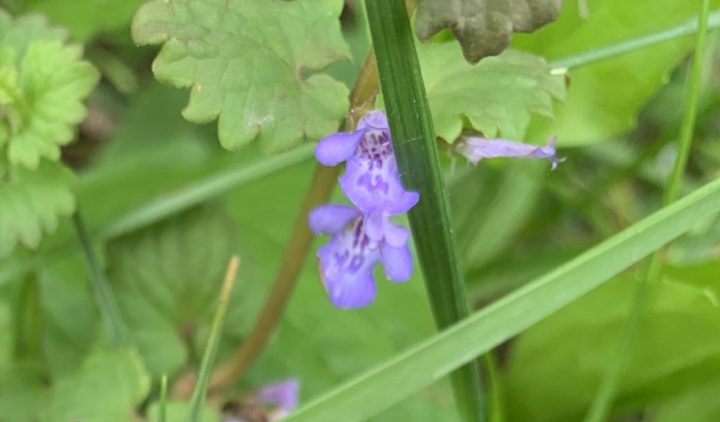
Irregular Ground Ivy!
This flower was found here: Spring Valley – Near the stream and by a field
It is on page 86 in Newcomb’s Wildflowers
Common name: Ground Ivy Scientific name: Glechoma hederacea
Corolla: 4 or 5 fused petals – Bottom petal could maybe be one, not two petals
Calyx: 5 fused sepals
Androecium: number of stamens _2_ separate, fused or arranged in any special way? Fused
Gynoecium type: syncarpous (and # of carpels =__1___)
How can you tell? The ovary was small and hard to tell but seemed chambered
Flower type/ovary position: perigynous
Flower symmetry: Zygomorphic (irregular)
Additional distinctive features: The petals and color make this one easy to identify! It is unfortunately invasive and as introduced in the 1800s as the medicinal plant and here it is! (https://www.invasive.org/alien/pubs/midatlantic/glhe.htm)
Flowers come in all shapes and sizes and even can hide in places you wouldn’t expect. By recognizing and observing them, we can start to really understand their world and their impact on our lives.
